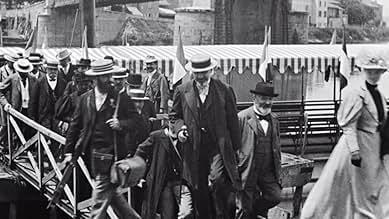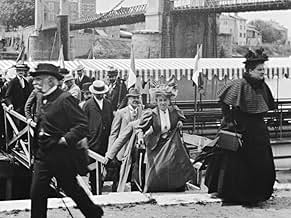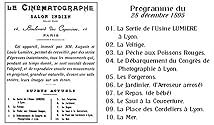IMDb-BEWERTUNG
5,7/10
2088
IHRE BEWERTUNG
Füge eine Handlung in deiner Sprache hinzuThe photographers who need to participate in the congress of Lyon get off a boat in Neuville-sur-Saône, dividing to the right and left.The photographers who need to participate in the congress of Lyon get off a boat in Neuville-sur-Saône, dividing to the right and left.The photographers who need to participate in the congress of Lyon get off a boat in Neuville-sur-Saône, dividing to the right and left.
- Regie
- Hauptbesetzung
P.J.C. Janssen
- Self
- (Nicht genannt)
Empfohlene Bewertungen
This interesting footage is particularly worth seeing as a companion piece to, and as a comparison with, the Lumière classic, "La Sortie des usines Lumière". The two features have much in common, and they are interesting for many of the same reasons.
In both movies, there is a rather sizable crowd moving towards the camera, knowing that they are being filmed. The main difference is that this movie features professional photographers, as they arrive to attend a congress of a photographic society. Their reactions are largely the same as were those of the factory workers, but many of the "professionals" seem more determined to hide their curiosity. On the other hand, a number of them show their interest even more eagerly, tipping their hats in a particularly jaunty fashion, demonstrating a bit of showmanship of their own.
As with the footage of the factory workers, the motion towards the camera is effective, and here the background scenery also has some interesting details. This film is also self-referential in one interesting respect, since the subjects of the film were also its initial audience. It's all rather interesting to take in.
In both movies, there is a rather sizable crowd moving towards the camera, knowing that they are being filmed. The main difference is that this movie features professional photographers, as they arrive to attend a congress of a photographic society. Their reactions are largely the same as were those of the factory workers, but many of the "professionals" seem more determined to hide their curiosity. On the other hand, a number of them show their interest even more eagerly, tipping their hats in a particularly jaunty fashion, demonstrating a bit of showmanship of their own.
As with the footage of the factory workers, the motion towards the camera is effective, and here the background scenery also has some interesting details. This film is also self-referential in one interesting respect, since the subjects of the film were also its initial audience. It's all rather interesting to take in.
10PCC0921
This film, along with nine other films, were shown at a Paris, mini-film festival, by pioneering filmmakers, the Lumiere brothers, in December of 1895. Most film historians place this date as the start of the film industry. The third movie ever shown to a paying audience, actually says a lot in its short 37 second runtime. The photographers disembark off of a passenger ferry in Neuville-sur-Saône, Rhône, France. Try to remember these guys aren't politicians, but photographers, assembling for a big meeting. The backdrop view of the bridge reminded me of various times in my life when I took a boat trip near a bridge that size. It created some nostalgia for me, which is the prime point of enjoying pioneering films from the silent era. Getting off a boat, feeling the waves underneath, taking in the fresh outside air, speaks volumes here. There are various restorations I found on YouTube for this film, that are really good. If you search you can find perfect versions of this movie.
I thought it was interesting seeing the photographers, tipping their hats to the film cameraman. It showed a respect between the photographers and the cinematographer himself. Being in the 21st century now and seeing it from this point of view, the first thing you think about is, a lot of these guys might lose their jobs someday to this new medium called moving pictures. They were having so much fun, assembling for their photography meeting, they didn't realize they were looking into their future, through the film camera lens of this new medium. Photography had been around for almost 60 years by this point and it begs to wonder if they felt threatened by the new technology that was looking them in the eye. The men coming off the boat created an atmosphere of foreshadowing. It was a preview of an era of innovations, that was coming to the world soon.
9.9 (A+ MyGrade) = 10 IMDB.
I thought it was interesting seeing the photographers, tipping their hats to the film cameraman. It showed a respect between the photographers and the cinematographer himself. Being in the 21st century now and seeing it from this point of view, the first thing you think about is, a lot of these guys might lose their jobs someday to this new medium called moving pictures. They were having so much fun, assembling for their photography meeting, they didn't realize they were looking into their future, through the film camera lens of this new medium. Photography had been around for almost 60 years by this point and it begs to wonder if they felt threatened by the new technology that was looking them in the eye. The men coming off the boat created an atmosphere of foreshadowing. It was a preview of an era of innovations, that was coming to the world soon.
9.9 (A+ MyGrade) = 10 IMDB.
To many historians, December 28, 1895, is the date considered as the day where cinema was born, as it was in that cold day of winter when the brothers Auguste and Louis Lumière gave the first public screening of their new invention, the Cinématographe. The brothers' devise would change history of entertainment forever, as it took the idea of motion pictures from the uncomfortable and individual experience of Edison's Kinetoscope, to the more enjoyable atmosphere of a movie projected on a screen. On that day the brothers showed 10 films, and the majority of them were of the kind that later would be known as "actuality films", movies showing an everyday event. However, one of the 10 films was a bit more than a typical "actuality film", as it was actually the register of an event in a fashion more akin to what we know now as documentary films: it was the arrival of the Photographical Congress to Lyon.
While December 28, 1895, was certainly the very first time the brothers showed their invention to the world, it wasn't really the first time the brothers' invention was shown to an audience, as months earlier, the brothers had been doing private screenings for the scientific community of France. The 1895 Photographical Congress that was celebrated at the community of Neuville-sur-Saône in Lyon, was one of the places where the Lumières screened their films for the first time. "Neuville-sur-Saône: Débarquement du congrès des photographes à Lyon", is essentially the recording of the arrival of the members of the Photographical Congress to Neuville-sur-Saône, marking the first time a camera was used to capture something more "special" than people moving or trains arriving. This time the new medium was being used to actually register the event in real time, pretty much in the same way as TV News work today.
Nevertheless, that was not the only thing that "Neuville-sur-Saône" an interesting early short film. The movie was shot when the Congress arrived, early in the morning, and that very same day was shown to its protagonists in the afternoon. One has to wonder how the photographers felt when they saw the images of their arrival actually moving, as if the even was being enacted again. The very same people that looked into the camera (perhaps thinking it was a normal photography) was now watching themselves in a motion picture depicting short seconds of their lives. It was certainly a unique experience, and no doubt the success of "Neuville-sur-Saône: Débarquement du congrès des photographes à Lyon" and their other films that day prompted the brothers to keep working in their preparation for that December day, when the world witnessed what a group of photographers did (and saw) months ago. 7/10
While December 28, 1895, was certainly the very first time the brothers showed their invention to the world, it wasn't really the first time the brothers' invention was shown to an audience, as months earlier, the brothers had been doing private screenings for the scientific community of France. The 1895 Photographical Congress that was celebrated at the community of Neuville-sur-Saône in Lyon, was one of the places where the Lumières screened their films for the first time. "Neuville-sur-Saône: Débarquement du congrès des photographes à Lyon", is essentially the recording of the arrival of the members of the Photographical Congress to Neuville-sur-Saône, marking the first time a camera was used to capture something more "special" than people moving or trains arriving. This time the new medium was being used to actually register the event in real time, pretty much in the same way as TV News work today.
Nevertheless, that was not the only thing that "Neuville-sur-Saône" an interesting early short film. The movie was shot when the Congress arrived, early in the morning, and that very same day was shown to its protagonists in the afternoon. One has to wonder how the photographers felt when they saw the images of their arrival actually moving, as if the even was being enacted again. The very same people that looked into the camera (perhaps thinking it was a normal photography) was now watching themselves in a motion picture depicting short seconds of their lives. It was certainly a unique experience, and no doubt the success of "Neuville-sur-Saône: Débarquement du congrès des photographes à Lyon" and their other films that day prompted the brothers to keep working in their preparation for that December day, when the world witnessed what a group of photographers did (and saw) months ago. 7/10
I watched this film on a DVD that was rammed with short films from the period. I didn't watch all of them as the main problem with these type of things that their value is more in their historical novelty value rather than entertainment. So to watch them you do need to be put in the correct context so that you can keep this in mind and not watch it with modern eyes. With the Primitives & Pioneers DVD collection though you get nothing to help you out, literally the films are played one after the other (the main menu option is "play all") for several hours. With this it is hard to understand their relevance and as an educational tool it falls down as it leaves the viewer to fend for themselves, which I'm sure is fine for some viewers but certainly not the majority. What it means is that the DVD saves you searching the web for the films individually by putting them all in one place but that's about it.
Anyway onto this film which is as the title suggests, lots of people getting off a boat. This is essentially a rerun of the Lumière film that saw lots of people leaving a factory and it is as exciting. The only thing that did make it interesting to me was the people in question react differently from those leaving the works in the other film. Maybe it is to do with their class, or maybe they are more savvy about cameras or maybe they are just told to do this but some wave, smile etc a reaction you would get today but interesting to see it then when such a thing was very much a novelty.
Other than this point of interest though, I found the film to be what it now is a historical novelty that can only be seen as such.
Anyway onto this film which is as the title suggests, lots of people getting off a boat. This is essentially a rerun of the Lumière film that saw lots of people leaving a factory and it is as exciting. The only thing that did make it interesting to me was the people in question react differently from those leaving the works in the other film. Maybe it is to do with their class, or maybe they are more savvy about cameras or maybe they are just told to do this but some wave, smile etc a reaction you would get today but interesting to see it then when such a thing was very much a novelty.
Other than this point of interest though, I found the film to be what it now is a historical novelty that can only be seen as such.
This film is a virtual remake of 'Sortie d'Usine', perhaps making it the first self-referential movie. Instead of the workers streaming out of the factory, we have fellow cinematograph specialists disembarking a liner for a congress. Instead of workers silently doing their masters' bidding, we have colleagues, friends, peers, fearlessly greeting the camera as equals.
This is a film about film - the Congressionists walk with their cameras; this film was precessed immediately for viewing at the conference. Already, the Lumieres' desire to 'objectively' record the world has turned into a naval-gazing admission of defeat, of the impossibility of objectivity untainted by subjectivity or ideology. Godard once suggested that the most honest film would be of a camera recording itself in a mirror. This film is an early grasping of what he means.
This is a film about film - the Congressionists walk with their cameras; this film was precessed immediately for viewing at the conference. Already, the Lumieres' desire to 'objectively' record the world has turned into a naval-gazing admission of defeat, of the impossibility of objectivity untainted by subjectivity or ideology. Godard once suggested that the most honest film would be of a camera recording itself in a mirror. This film is an early grasping of what he means.
Wusstest du schon
- VerbindungenEdited into The Lumière Brothers' First Films (1996)
Top-Auswahl
Melde dich zum Bewerten an und greife auf die Watchlist für personalisierte Empfehlungen zu.
Details
- Erscheinungsdatum
- Herkunftsland
- Sprache
- Auch bekannt als
- The Photographical Congress Arrives in Lyon
- Drehorte
- Produktionsfirma
- Weitere beteiligte Unternehmen bei IMDbPro anzeigen
- Laufzeit
- 1 Min.
- Farbe
- Sound-Mix
- Seitenverhältnis
- 1.33 : 1
Zu dieser Seite beitragen
Bearbeitung vorschlagen oder fehlenden Inhalt hinzufügen





















